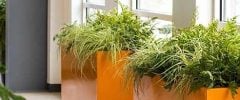Three Common Poinsettia Plant Myths

The one plant I dread dealing with most each season is the poinsettia. With its showy bright red and green bracts, the poinsettia plant is a festive accessory for any interior holiday design. However, I find it difficult to keep this temperamental foliage looking good for six weeks. Every year, I get the same questions and comments from customers, and I thought it would be a good idea to dispel some common myths about this popular holiday favorite.
Myth #1: Poinsettias are poisonous
Perhaps the bright red warning color or the milky sap that drips from broken stems give people the impression that poinsettias are poisonous. Of course, if massive amounts are ingested, you or a pet may suffer from stomach pain and indigestion. However, a study by the University of Ohio found that the foliage isn’t deadly or toxic. In fact, the poinsettia was first discovered by the Aztecs, who used the plant as a headache remedy as well as a cloth dye. Despite scientific evidence, the myth that poinsettias are poisonous continues to spread. Every year, without fail, I get a handful of people who prefer not to have poinsettias around.
Myth #2: Poinsettias like the cold
Since poinsettias are most often seen around the holiday season, it’s understandable why many people think these plants prefer the cold. The fact is, being outside in temperatures below forty degrees will harm them. Poinsettias come from South America—a tropical climate—and prefer warm, lush environments.
To keep poinsettias alive and well, place them away from drafty doors or windows, and don’t place them in outdoor locations where they can frost. Since poinsettias are tropical, keeping the soil consistently moist will prolong their life. I highly recommend checking the soil every few days. You don’t want them sitting in water, but if you let the roots dry out too much, it’s almost impossible to revive them. Finding this perfect balance can be tricky during the winter months when heating systems are running regularly, drying out the interior air and making it more difficult to maintain even soil moisture. I find adding a soil amendment such as water crystals, beads, or even pieces of floral aqua foam to be very helpful.
Myth #3: Poinsettias are flowers
Many people I encounter believe poinsettias are the number one holiday plant because they grow large red flowers during the winter. Technically, though, they’re classified as a bush—the red tops are not flowers, but leaves called bracts. In their natural habitat, as days get shorter and the sun’s intensity decreases, the poinsettia’s top leaves change to a red hue. Growers mimic this in greenhouses by using shade cloths to regulate light, a process known as photoperiodism, to encourage this color development.
Maintaining poinsettias is tough unless they’re in a greenhouse. Their leaves, once dried out, tend to crumble into pieces. For that reason alone, many people discard the plants. Yet, even if the foliage is in bad shape, the roots might still be viable, and pruning and placing the plant in a warm, sunny area with even moisture can help the foliage regrow. Still, despite the many misconceptions that surround poinsettias, they are destined to be a holiday season staple. While they may not be my top choice for festive displays, they undeniably add holiday cheer where placed.
You May Also Like
Leave a Reply
You must be logged in to post a comment.




















